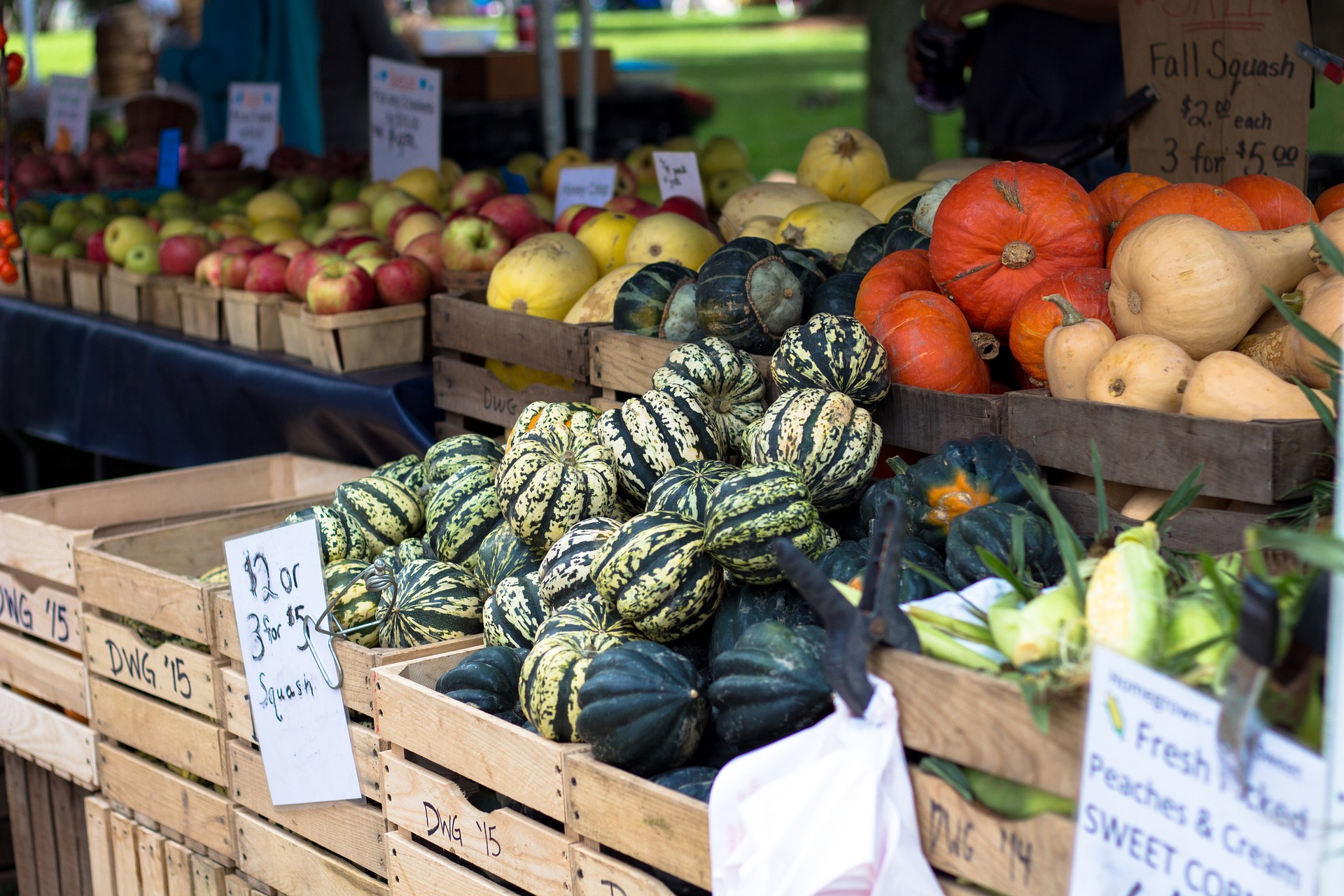Basically everything has changed. COVID-19 has left no aspect of life untouched, and that includes the ever-important area of food. Everybody eats, but food is often more than just a requirement for sustenance. So what has changed in the way we get food during this pandemic? Restaurants have shut down, grocery stores are packed nightmares and online meal kits have become a popular new trend. But what about farmers markets?
Farmers markets are about bringing fresh, healthy, local food from farms to customers, but they’re also about more than that. Farmers markets are often hot spots for communities to gather and bond. Before COVID-19, farmers markets were hubs for congregating to enjoy music, art, food, crafts and other activities. It was a place to go to feel connected with your neighbors and friends while getting quality food. Now, they have to forgo the beloved social aspect to prevent the spread of this virus, while still fulfilling its core purpose of food retailing.
Farmers markets are a substantial food source for many communities, despite the U.S. government not always treating them as such. Throughout the country, some states have required the complete shutdown of farmers markets. Thankfully, the government is now treating them as the essential businesses that they are and allowing farmers markets to get back up and running. However, they look a little different now.
For the markets that are allowed to reopen, new protocols have been put in place. Every farmers market is undoubtedly unique in its setup, but there are some common guidelines most have implemented. Start with the entrance. Most entrances are now specifically labeled, with exits located elsewhere to direct the flow of foot traffic. Additionally, at the entrances there are usually more informative signs explaining how to properly and safely proceed once inside.
As with any public area, masks and social distancing are required. Once inside the markets, masked customers are advised to stay at least six feet apart, whether walking from booth to booth or waiting in line. Vendors are also clad in personal protective equipment and maintain their distance between each other to keep themselves and their customers safe.
Farmers markets have added new sanitation stations throughout the venues to keep everyone germ-free and healthy. Where there might have formerly been a booth, you might now find a hand-washing station. Extra bathrooms have also been installed to allow vendors and customers alike to keep up the practice of frequent hand-washing.
Despite promoting keeping hands clean, farmers markets have also implemented no-touching rules. The practice of “shopping with your eyes” is aided by tangible measures. The bins that one could previously scour through to find the perfect tomato or zucchini have been removed. Grabbing a grape or cherry tomato to sample is no longer an option. Vendors handle the bagging and picking for the customers.
Another method to limit person-to-person contact is barriers. A common food guard being implemented is an empty table between the vendors’ tables and the customers’ aisles. It all falls on the vendors’ (gloved) hands now.
The contact between shopper and vendor is largely confined to payment. The process for paying for the locally grown commodities has adapted as well. Where previously one vendor may have handled both the food and the cash register, there is now often one designated person to handle food, and another to handle money. On the customer end, shoppers are encouraged to go with contactless payment when possible. Farmers market organizations are working to install more registers that accept hands-free payment, such as Apple Pay, including for those who have SNAP and WIC benefits. However, payment with cash and coins is still widely accepted at markets for those who can’t go contactless.
Once marketgoers have their goods, they are encouraged to leave the market. No more sitting around to enjoy the recently purchased food and chatting with friends. Customers are asked to pick out their food and go. It should no longer be an all-day event.
Most farmers markets have changed their scheduling policies. Time slots for at-risk shoppers have been planned out. Some markets have online booking for customers to pick a time slot to come and shop during. Marketgoers are encouraged to plan out what they want before coming to the market, or to preorder when shopping in the market itself is the only option.
Farmers markets have changed style as well as setup. The physical venues have expanded their shopping options. Instead of walking through a market, a drive-thru might be the new mode. One can drive up to the stall, pick out their produce, and have the farmer place the items in the trunk or back seat. Preorders are also offered in these drive-thru farmers markets, where your name on a little sheet of paper in your windshield aids the vendors.
Some farmers markets have moved past having a physical location. Several offer to ship the produce right to your door, which is similar to the large meal-kit companies, but with the benefit of shopping locally. Another inventive method for shoppers is to go straight to the farm to pick up their favorite foods.
Just because a pandemic is happening doesn’t mean farmers markets are down for the count. They are highly resilient and adaptive organizations dedicated to serving the community. They are working diligently to provide access to healthy and affordable food to their local communities, so whether you’re a previous or first-time buyer, please support farmers markets now and in the future.
The primary way to support farmers markets is to buy their products. National Farmers Market Week is Aug. 2-8 and could be the perfect time for you to try one out. Remember to support Black farmers and farmers from other oppressed communities if you can. Buying from farms is a great way to show support for BLM because “food justice starts with racial justice.”
Do you already buy from farmers markets? There are still actions you can take to help solidify farmers markets’ existence. Farmers markets are usually nonprofits and rely on aid from the government and grants. You can email your local government demanding that farmers markets be made essential businesses and included in relief packages with this pre-made template. You can send links to grant applications to your favorite local farmers or farmers market coordinator. You can also help to fund important grants like the Kentucky Black Farmer Fund or organizations that support Black farmers in your local area. You can even create your own farmers markets for under-represented communities if you don’t already have one near you.
If those seem like daunting ways to aid farmers markets, there are smaller steps you can take. Send a thank-you to your local farmer or farmers market managers. Encourage friends and family to shop from a farmers market. Be mindful of the ways in which farmers markets benefit your community. We can all do something to make the world a little better, especially during these trying times. Why not start local with farmers markets?
















